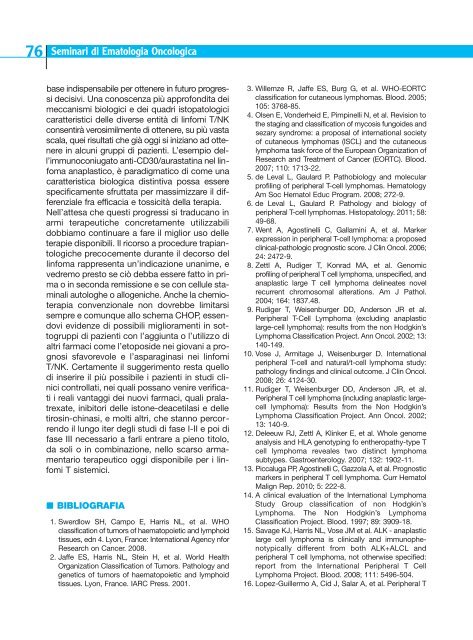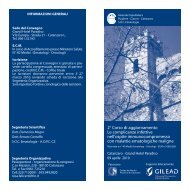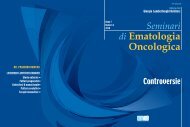Seminari di Ematologia Oncologica - Società Italiana di Ematologia
Seminari di Ematologia Oncologica - Società Italiana di Ematologia
Seminari di Ematologia Oncologica - Società Italiana di Ematologia
You also want an ePaper? Increase the reach of your titles
YUMPU automatically turns print PDFs into web optimized ePapers that Google loves.
76 <strong>Seminari</strong> <strong>di</strong> <strong>Ematologia</strong> <strong>Oncologica</strong><br />
base in<strong>di</strong>spensabile per ottenere in futuro progressi<br />
decisivi. Una conoscenza più approfon<strong>di</strong>ta dei<br />
meccanismi biologici e dei quadri istopatologici<br />
caratteristici delle <strong>di</strong>verse entità <strong>di</strong> linfomi T/NK<br />
consentirà verosimilmente <strong>di</strong> ottenere, su più vasta<br />
scala, quei risultati che già oggi si iniziano ad ottenere<br />
in alcuni gruppi <strong>di</strong> pazienti. L’esempio dell’immunoconiugato<br />
anti-CD30/aurastatina nel linfoma<br />
anaplastico, è para<strong>di</strong>gmatico <strong>di</strong> come una<br />
caratteristica biologica <strong>di</strong>stintiva possa essere<br />
specificamente sfruttata per massimizzare il <strong>di</strong>fferenziale<br />
fra efficacia e tossicità della terapia.<br />
Nell’attesa che questi progressi si traducano in<br />
armi terapeutiche concretamente utilizzabili<br />
dobbiamo continuare a fare il miglior uso delle<br />
terapie <strong>di</strong>sponibili. Il ricorso a procedure trapiantologiche<br />
precocemente durante il decorso del<br />
linfoma rappresenta un’in<strong>di</strong>cazione unanime, e<br />
vedremo presto se ciò debba essere fatto in prima<br />
o in seconda remissione e se con cellule staminali<br />
autologhe o allogeniche. Anche la chemioterapia<br />
convenzionale non dovrebbe limitarsi<br />
sempre e comunque allo schema CHOP, essendovi<br />
evidenze <strong>di</strong> possibili miglioramenti in sottogruppi<br />
<strong>di</strong> pazienti con l’aggiunta o l’utilizzo <strong>di</strong><br />
altri farmaci come l’etoposide nei giovani a prognosi<br />
sfavorevole e l’asparaginasi nei linfomi<br />
T/NK. Certamente il suggerimento resta quello<br />
<strong>di</strong> inserire il più possibile i pazienti in stu<strong>di</strong> clinici<br />
controllati, nei quali possano venire verificati<br />
i reali vantaggi dei nuovi farmaci, quali pralatrexate,<br />
inibitori delle istone-deacetilasi e delle<br />
tirosin-chinasi, e molti altri, che stanno percorrendo<br />
il lungo iter degli stu<strong>di</strong> <strong>di</strong> fase I-II e poi <strong>di</strong><br />
fase III necessario a farli entrare a pieno titolo,<br />
da soli o in combinazione, nello scarso armamentario<br />
terapeutico oggi <strong>di</strong>sponibile per i linfomi<br />
T sistemici.<br />
n BIBLIOGRAFIA<br />
1. Swerdlow SH, Campo E, Harris NL, et al. WHO<br />
classification of tumors of haematopoietic and lymphoid<br />
tissues, edn 4. Lyon, France: International Agency nfor<br />
Research on Cancer. 2008.<br />
2. Jaffe ES, Harris NL, Stein H, et al. World Health<br />
Organization Classification of Tumors. Pathology and<br />
genetics of tumors of haematopoietic and lymphoid<br />
tissues. Lyon, France. IARC Press. 2001.<br />
3. Willemze R, Jaffe ES, Burg G, et al. WHO-EORTC<br />
classification for cutaneous lymphomas. Blood. 2005;<br />
105: 3768-85.<br />
4. Olsen E, Vonderheid E, Pimpinelli N, et al. Revision to<br />
the staging and classification of mycosis fungoides and<br />
sezary syndrome: a proposal of international society<br />
of cutaneous lymphomas (ISCL) and the cutaneous<br />
lymphoma task force of the European Organization of<br />
Research and Treatment of Cancer (EORTC). Blood.<br />
2007; 110: 1713-22.<br />
5. de Leval L, Gaulard P. Pathobiology and molecular<br />
profiling of peripheral T-cell lymphomas. Hematology<br />
Am Soc Hematol Educ Program. 2008; 272-9.<br />
6. de Leval L, Gaulard P. Pathology and biology of<br />
peripheral T-cell lymphomas. Histopatology. 2011; 58:<br />
49-68.<br />
7. Went A, Agostinelli C, Gallamini A, et al. Marker<br />
expression in peripheral T-cell lymphoma: a proposed<br />
clinical-pathologic prognostic score. J Clin Oncol. 2006;<br />
24: 2472-9.<br />
8. Zettl A, Ru<strong>di</strong>ger T, Konrad MA, et al. Genomic<br />
profiling of peripheral T cell lymphoma, unspecified, and<br />
anaplastic large T cell lymphoma delineates novel<br />
recurrent chromosomal alterations. Am J Pathol.<br />
2004; 164: 1837.48.<br />
9. Ru<strong>di</strong>ger T, Weisenburger DD, Anderson JR et al.<br />
Peripheral T-Cell Lymphoma (exclu<strong>di</strong>ng anaplastic<br />
large-cell lymphoma): results from the non Hodgkin’s<br />
Lymphoma Classification Project. Ann Oncol. 2002; 13:<br />
140-149.<br />
10. Vose J, Armitage J, Weisenburger D. International<br />
peripheral T-cell and natural/t-cell lymphoma study:<br />
pathology fin<strong>di</strong>ngs and clinical outcome. J Clin Oncol.<br />
2008; 26: 4124-30.<br />
11. Ru<strong>di</strong>ger T, Weisenburger DD, Anderson JR, et al.<br />
Peripheral T cell lymphoma (inclu<strong>di</strong>ng anaplastic largecell<br />
lymphoma): Results from the Non Hodgkin’s<br />
Lymphoma Classification Project. Ann Oncol. 2002;<br />
13: 140-9.<br />
12. Deleeuw RJ, Zettl A, Klinker E, et al. Whole genome<br />
analysis and HLA genotyping fo entheropathy-type T<br />
cell lymphoma reveales two <strong>di</strong>stinct lymphoma<br />
subtypes. Gastroenterology. 2007; 132: 1902-11.<br />
13. Piccaluga PP, Agostinelli C, Gazzola A, et al. Prognostic<br />
markers in peripheral T cell lymphoma. Curr Hematol<br />
Malign Rep. 2010; 5: 222-8.<br />
14. A clinical evaluation of the International Lymphoma<br />
Study Group classification of non Hodgkin’s<br />
Lymphoma. The Non Hodgkin’s Lymphoma<br />
Classification Project. Blood. 1997; 89: 3909-18.<br />
15. Savage KJ, Harris NL, Vose JM et al. ALK - anaplastic<br />
large cell lymphoma is clinically and immunophe -<br />
notypically <strong>di</strong>fferent from both ALK+ALCL and<br />
peripheral T cell lymphoma, not otherwise specified:<br />
report from the International Peripheral T Cell<br />
Lymphoma Project. Blood. 2008; 111: 5496-504.<br />
16. Lopez-Guillermo A, Cid J, Salar A, et al. Peripheral T






